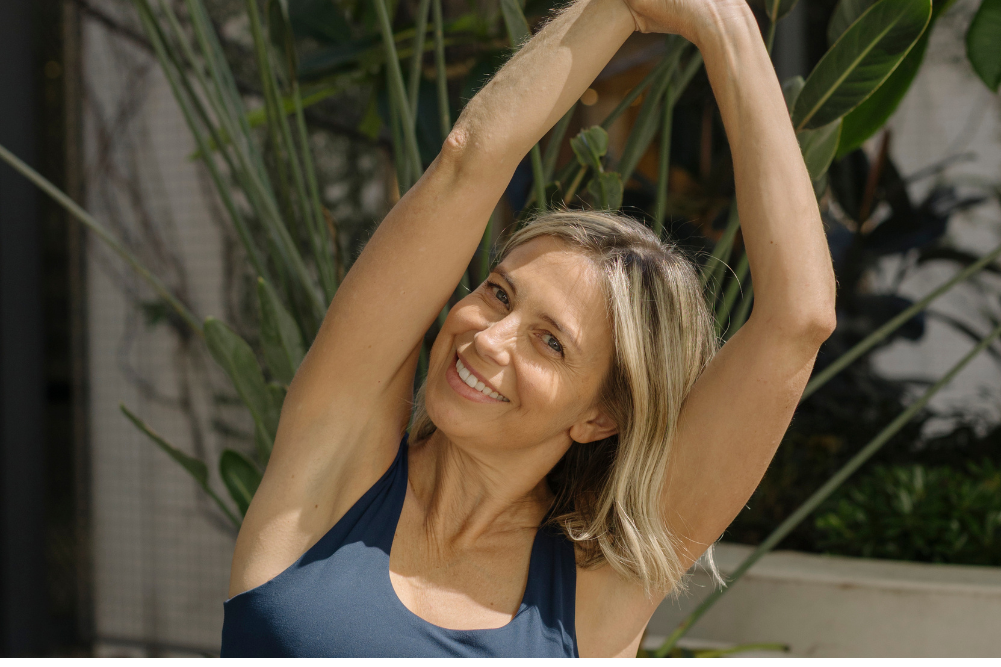Yoga for the fourth trimester
Yogis are blessed with so many wonderful tools for support in the transition from maiden to mother. Here’s everything you need to know about yoga for the fourth trimester.
Words GABRIELA FEARN
During my first pregnancy, I was obsessed with having a peaceful, unmedicated birth. I opted for midwifery care through a birth centre, hired a doula, did a Calmbirth course, had regular acupuncture and massage, practised yoga, meditated, visualised and read everything I could about pregnancy and birth. But other than throwing a few meals into the freezer, I did zero, zip, nada to prepare myself for life with a newborn.
As a doula as well as prenatal and postnatal yoga teacher, I now recognise this as a common pattern. It’s like the couple who spend all their energy planning their wedding while giving no thought to their marriage.
Don’t get me wrong, birth is important and I believe that all birthing women should make empowered choices when it comes to how they birth their babies. But in the grand scheme of things, the birth is just one day (or if you’re unlucky like me, a couple of days), while the fourth trimester lasts for three months. Oh, and life as a parent … well that lasts forever.
What is the fourth trimester?
The fourth trimester refers to the first few months of your baby’s life. Human babies are born very immature, and for the first few months they still want to feel like they’re inside the womb. Your baby will probably want to be held all the time, and you will be tired and sore after the. I always tell my prenatal yoga students that giving birth is like climbing a mountain — if you climbed an actual mountain, you would need time to rest and recuperate afterwards.
You’ll be drained physically and emotionally. Your core and pelvic floor will need time to recover. You’ll have a placenta-sized wound inside your uterus.
You’ll be dealing with changing hormone levels and around three days postpartum, your hormones drop dramatically and it is normal to feel all emotions. This is also right around the time your milk comes in. As you can see, there is a lot going on for the postpartum mama and our culture doesn’t tend to share how postpartum physiological recovery is a normal part of the process.
A saying I’ve often heard is “40 days for 40 years”. The idea is that the 40 days after childbirth are so important for a woman’s health that they will affect her health for the next 40 years. In many cultures around the world, new mothers stay home for 40 days — resting and breastfeeding — while family members take care of the home, other children and, of course, the new mum. These traditions can come with strict protocols that may not suit every new parent, such as staying indoors for 40 days.
The idea of staying home for that long can be completely unrealistic (or undesirable), but if you have just had a baby, I encourage you to take on the idea of sacred rest and bonding time after your baby is born for as long as you wish. There is often too much pressure placed on new mums to get out there and get back to normal. And there are the ridiculous expectations to get back to our “pre-baby bodies”.
As my own two daughters grow up, I can’t help but think back to their newborn days with so much love and tenderness. It was hard and exhausting, but it was also magical. I remember feeling as if I was in a bubble of bliss, spending countless hours feeding, cuddling and staring at my new baby. It’s not always easy, but try to see this time for what it is: fleeting. Enjoy the time, be grateful for the gift of your precious child and make your home a haven.
As yogis, we are blessed with so many wonderful tools that can support us in our transition from maiden to mother. I used to struggle to answer the question of why I practise yoga, but now I say: “I practise yoga to remember the truth of who I am.” And nowhere was that more obvious than during my own matrescence — the sacred experience of becoming a mother.
Despite losing so much of my sense of self during that period, through my yoga practice I could still feel a connection to my true self. My practice has been there for me at every step of my mothering journey, whether it was breathing deeply during hours spent nursing, doing yoga nidra while the baby slept or just stretching out my stiff neck and shoulders.
Self-care tips for postpartum
Regardless of how your birth unfolded, these self-care tips will support you in the postpartum period:
- Sleep when the baby sleeps. Seriously.
- Belly wrapping is an ancient Ayurvedic tradition that helps to contain the excessive vata that is now present in the womb. Vata is associated with air and, when it’s imbalanced, symptoms include feeling cold, tired and scattered. Aim for light compression, as too much can compromise the pelvic floor. Physically, this may help with abdominal separation, to stabilise loosened ligaments and improve posture.
- Oil massage is also helpful in reducing excess vata. You can rub your belly with warm, organic sesame oil then wrap your belly.
- Eat when the baby eats. A newborn will typically feed 12 times in a 24-hour period; take advantage of this time to nourish yourself! To balance excess vata, stick to a diet of warm, easy-to-digest foods such as soups, stews, casseroles and bone broths.
- Take salt baths. Make sure that the bath is clean (to prevent infection), and dissolve salt into the water as the bath is filling up. The water should come up to the level between your pubic bone and navel. You can add herbs including lavender, calendula or chamomile. Wait at least 24 hours after giving birth for swelling to subside.
- Store the contact info for anyone you might need to reach out to: lactation consultant, postpartum doula, GP, postpartum mental health professional, midwife and any family or friends you can call on for help.
- All of your energy should go towards healing your body and caring for your baby, so it’s worth limiting visitors. It helps to have a partner or friend who can protect your space and set expectations for visitors. When people do come over, give yourself permission to prioritise your needs. Ask them for help so you can take a shower or a nap.
- Be kind to yourself. This time can be overwhelming, but remember that taking care of yourself isn’t selfish! Take a bath, do yoga nidra, sit outside in the sunshine, watch a funny show or drink a cup of tea. Remember that what’s good for you is good for your baby.
The dos and don’ts of your postpartum yoga practice
- Go slowly and don’t place any undue expectations on yourself.
- Start with gentle pelvic floor exercises that help you reconnect with this part of your body and move on from there to explore the transverse abdominis-pelvic floor connection.
- See a women’s health physiotherapist anytime from six weeks postpartum.
- I recommend avoiding exercise that includes running or jumping until at least six months postpartum.
- Don’t overstretch. Hypermobility and instability are still issues as the hormone relaxin affects your ligaments and joints. Relaxin stays relatively high for several months after having a baby.
- For the first two to three months postpartum, avoid deep backbends, core work that engages your superficial abdominal muscles, pranayama practices like kapalabhati that can put excess strain on the pelvic floor and abdominals, as well as poses that put too much pressure on the groin such as unsupported bound angle pose.
- Mind your posture: think about rolling your shoulders back, keeping your pelvis neutral and stacking your ribs over your pelvis (with your ribs relaxed down). This optimises your breathing and core function.
- Practise patience and continue to check in with your intuition.
Your early postpartum practice
Remember that if you progress too quickly and ignore your body’s signs, you can not only prevent your body from healing but can also do yourself harm. Now is not the time to push yourself, or rigidly hold on to ideas of what you should be able to do or what your body used to be able to do. With gratitude for your amazing body and everything it has done and continues to do in supporting your baby, let’s practise in a way that honours your energy levels, mood, how much sleep you’ve had, how you’re feeling and what you need.
Pelvic floor activation with block
Lie down with your feet on the floor and your knees bent. Place your hands in a triangle shape just below your belly button and do a few pelvic rocks to find your neutral pelvis. Take some deep breaths. You don’t want your breath to balloon your belly; instead, think about breathing into your ribs and try to feel them moving side to side, and front to back (you can place your hands on your ribs to help feel this). Without forcing it, notice how as you exhale your pelvic floor naturally draws up and as you inhale it moves down.
Now place a yoga block between your thighs, maintain your neutral pelvis and begin to gently draw your pelvic floor muscles up as you exhale. You can visualise your pelvic floor as a lift going up the storeys of a building. Relax the muscles completely as you inhale. If you find that your belly is doming as you do this, go back to the beginning and reconnect with your breath.
Upper back release
Take a rolled-up towel or blanket and place it across your mat. Lie over the towel or blanket so it rests against the bottom of your shoulder blades and take your arms out as wide as is comfortable, palms up. If you need more support, you can place a pillow under your head and a bolster under your knees. Rest here for two to five minutes.
Neck stretch
Sit comfortably and reach your right arm away from you, with your elbow slightly bent and your palm up. Externally rotate your upper arm and shoulder so your right thumb points behind you. Take your left ear towards your left shoulder and hold for three to five breaths. Next, make some small circles with your right arm. Relax your jaw and all the muscles of your face. Release and change sides.
Side bend
From a seat, reach your right arm high as you inhale and bend to your left as you exhale. Make sure your ribs aren’t flaring and your neck is relaxed. Flow with your breath, inhaling up, exhaling over. When you’re ready, hold each side bend for three to five breaths. Lateral flexion of the spine feels so nice when our upper body is sore. If you have a cesarean scar and this movement irritates it, press pause on this one for now.
Twist
Feel free to change your seated position; kneeling can help square the pelvis. Take your right hand to your left thigh, inhale to lengthen your spine and, as you exhale, twist to your left and rest your left hand on the floor behind you. Focus on the twist coming from your thoracic (mid-region) spine and keep your collarbones broad.
Cat/cow
Come to all-fours, with your hips over your knees and your shoulders over your hands. Starting with an exhale, curl your spine and release your head, arching your back like a cat. On an inhale, begin to lift your tailbone, hug your shoulder blades together and raise your chin. Don’t turn this into a big backbend — think gentle heart-opener. If it’s causing your belly to dome or your lower back to hurt, skip it for now.
Legs-up-the-wall
This is all about shifting into rest-and-digest mode. You can use a pillow under your head and a blanket over your belly. Lie on your back, raise your legs and rest them against a wall. Place your hands wherever is comfortable. As mums we do so much for everyone around us; this is your time to rest and unwind.








